
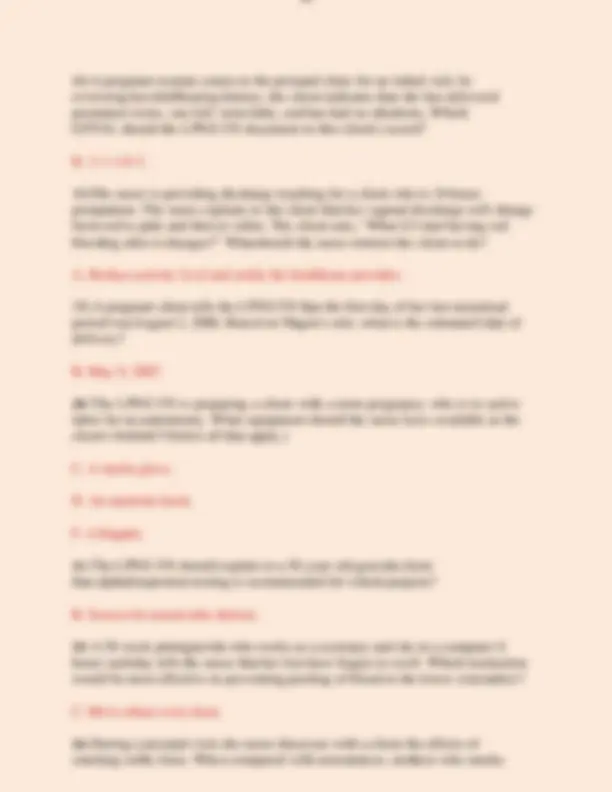

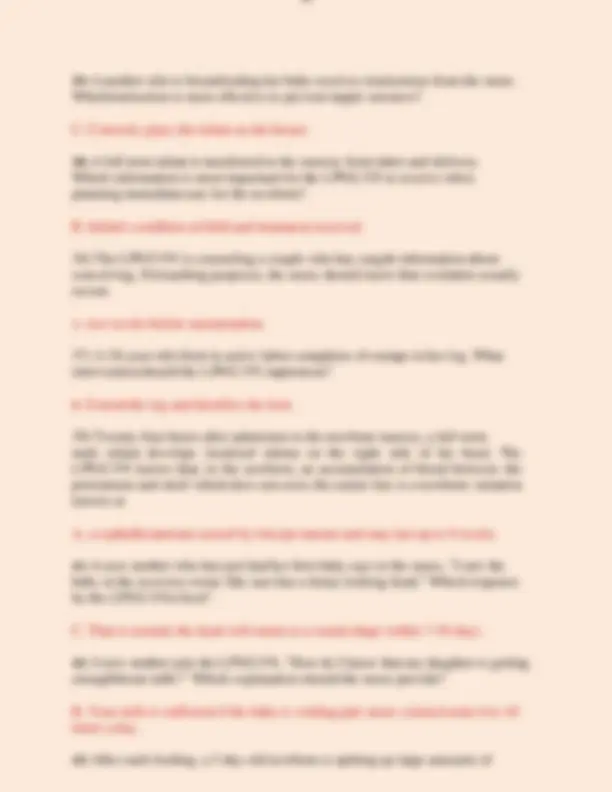

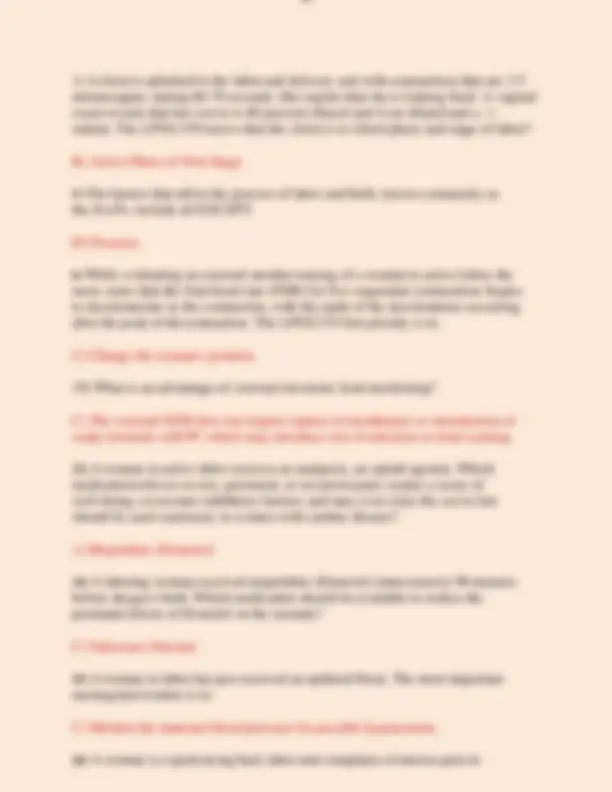

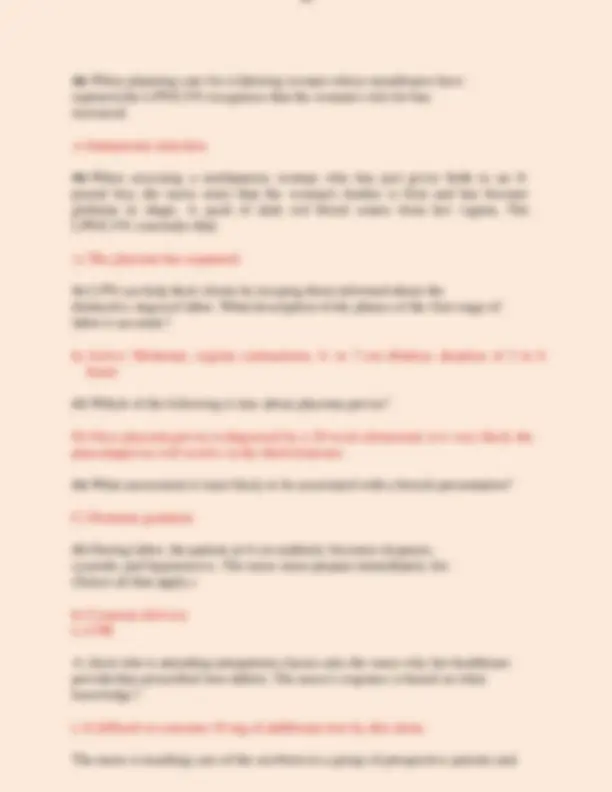

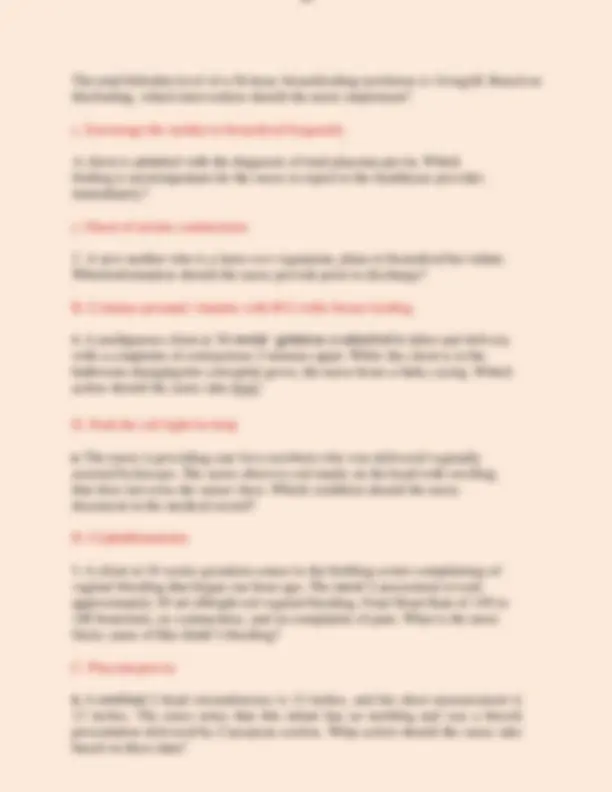
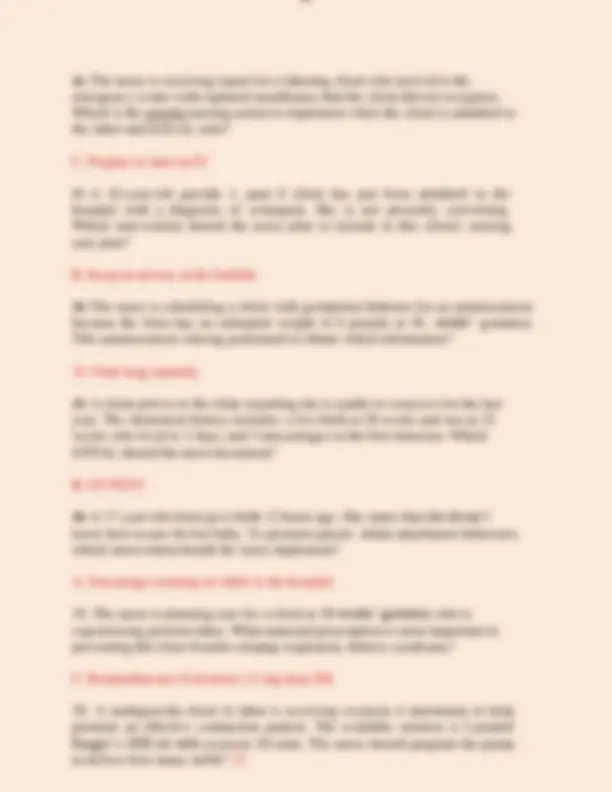

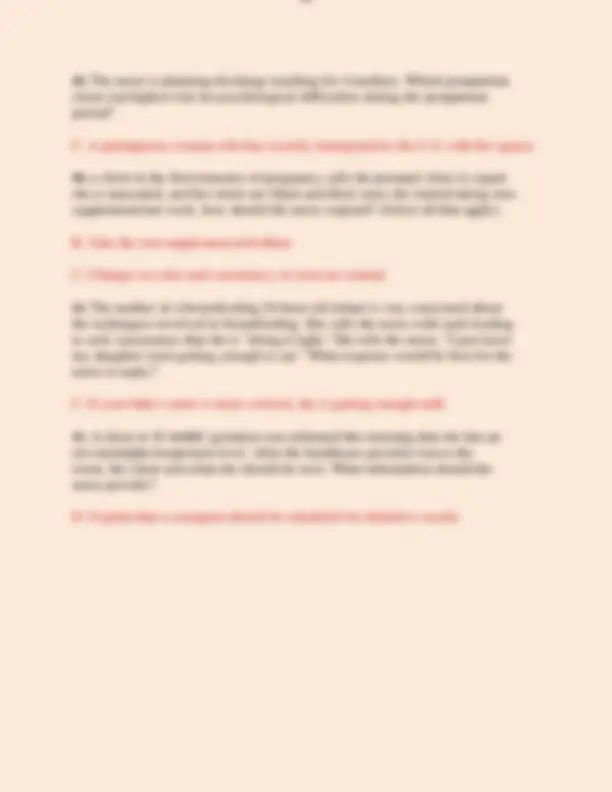


Study with the several resources on Docsity

Earn points by helping other students or get them with a premium plan


Prepare for your exams
Study with the several resources on Docsity

Earn points to download
Earn points by helping other students or get them with a premium plan
Community
Ask the community for help and clear up your study doubts
Discover the best universities in your country according to Docsity users
Free resources
Download our free guides on studying techniques, anxiety management strategies, and thesis advice from Docsity tutors
2024 HESI PN MATERNITY EXAM QUESTIONS & CORRECT ANSWERS GRADED A LATEST EXAM
Typology: Exams
1 / 20

This page cannot be seen from the preview
Don't miss anything!













1) At 14-weeks gestation, a client arrives at the Emergency Center complaining of a dull pain in the right lower quadrant of her abdomen. The LPN/LVN obtains a blood sample and initiates an IV. Thirty minutes after admission, the client reports feeling a sharp abdominal pain and a shoulder pain. Assessment findings include diaphoresis, a heart rate of 120 beats/minute, and a blood pressure of 86/48. Which action should the nurse implement next? C. Increase the rate of IV fluids. 2) During a prenatal visit, the LPN/LVN discusses with a client the effects of smoking on the fetus. When compared with nonsmokers, mothers who smoke during pregnancy tend to produce infants who have D. a higher rate of congenital anomalies. 3) Which action should the LPN/LVN implement when preparing to measure the fundal height of a pregnant client? A. Have the client empty her bladder.
A. Initiate positive pressure ventilation
during pregnancy tend to produce infants who have: B. lower birth weight
29) A mother who is breastfeeding her baby receives instructions from the nurse. Which instruction is most effective to prevent nipple soreness? C. Correctly place the infant on the breast. 30) A full term infant is transferred to the nursery from labor and delivery. Which information is most important for the LPN/LVN to receive when planning immediate care for the newborn? B. Infant's condition at birth and treatment received.
44) A client who gave birth to a healthy 8 pound infant 3 hours ago is admitted to the postpartum unit. Which nursing plan is best in assisting this mother to bond with her newborn infant? D. Meet the mother's physical needs and demonstrate warmth toward the infant. 45) Which nursing intervention is most helpful in relieving postpartum uterine contractions or "afterpains?" A. Lying prone with a pillow on the abdomen. 46) Which maternal behavior is the LPN/LVN most likely to see when a new mother receives her infant for the first time? B. Her arms and hands receive the infant and she then traces the infant's profile with her fingertips.
tissue.
her lower back. An effective relief measure would be to use: A) Counterpressure against the sacrum
27) A woman has requested an epidural for her pain. She is 5 cm dilated and 100% effaced. The baby is in a vertex position and is engaged. The LPN/LVN increases the woman's intravenous fluid for a pre-procedural bolus. She reviews her laboratory values and notes that the woman's hemoglobin is 12 g/dl, hematocrit is 38%, platelets are 67,000, and white blood cells (WBCs) are 12,000/mm3. Which factor would contraindicate an epidural for the woman? C) She has thrombocytopenia
48) When planning care for a laboring woman whose membranes have ruptured, the LPN/LVN recognizes that the woman's risk for has increased. A) Intrauterine infection 50) When assessing a multiparous woman who has just given birth to an 8 - pound boy, the nurse notes that the woman's fundus is firm and has become globular in shape. A gush of dark red blood comes from her vagina. The LPN/LVN concludes that: A) The placenta has separated. 51) LPN can help their clients by keeping them informed about the distinctive stages of labor. What description of the phases of the first stage of labor is accurate? B) Active: Moderate, regular contractions; 4- to 7 - cm dilation; duration of 3 to 6 hours 53) Which of the following is true about placenta previa? D) Once placenta previa is diagnosed by a 20 week ultrasound, it is very likely the placenta previa will resolve in the third trimester. 54) What assessment is least likely to be associated with a breech presentation? C) Postterm gestation 55) During labor, the patient at 4 cm suddenly becomes dyspneic, cyanotic, and hypotensive. The nurse must prepare immediately for: (Select all that apply.) B) Cesarean delivery C) CPR A client who is attending antepartum classes asks the nurse why her healthcare provider has prescribed iron tablets. The nurse's response is based on what knowledge? b. It difficult to consume 18 mg of additional iron by diet alone The nurse is teaching care of the newborn to a group of prospective parents and
describes the need for administering antibiotic ointment into the eyes of the newborn. Which infectious organism will this treatment prevent from harming the infant? c. Gonorrhea The nurse is calculating the estimated date of confinement (EDC) using Nagele's rule for a client whose last menstrual period started on December 1. Which date is most accurate? d. September 8
C. Record the findings on the chart. They are within normal limits
49. The nurse is planning discharge teaching for 4 mothers. Which postpartum client is at highest risk for psychological difficulties during the postpartum period? C. A primiparous woman who has recently immigrated to the U.S. with her spouse 50. a client in the first trimester of pregnancy calls the prenatal clinic to report she is nauseated, and her stools are black and thick since she started taking iron supplements last week. how should the nurse respond? (Select all that apply) B. Take the iron supplement at bedtime C. Changes in color and consistency of stool are normal 54. The mother of a breastfeeding 24-hour-old infant is very concerned about the techniques involved in breastfeeding. She calls the nurse with each feeding to seek reassurance that she is "doing it right." She tells the nurse, "I just know my daughter is not getting enough to eat." What response would be best for the nurse to make? C. If your baby's urine is straw-colored, she is getting enough milk 55. A client at 18-weeks’ gestation was informed this morning that she has an elevated alpha fetoprotein level. After the healthcare provider leaves the room, the client asks what she should do next. What information should the nurse provide? D. Explain that a sonogram should be scheduled for definitive results